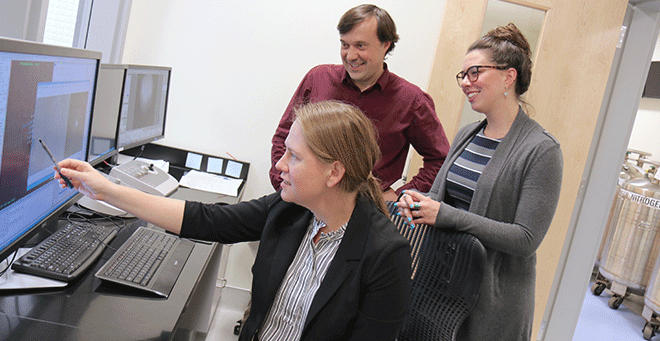
|
The stages in which ribosomes synthesize life-sustaining proteins have been revealed in unprecedented real-time detail by UMass Medical School structural biologists Andrei Korostelev, PhD, and Anna Loveland, PhD. Their new study of this fundamental molecular mechanism, captured using state-of-the-art, time-resolved, cryo-electron microscopy was published by the journal Nature on July 1.
Ribosomes are the molecular machines that read genetic instructions carried by messenger RNA (mRNA) and translate the instructions into proteins by joining different amino acids. (Amino acids are brought to the ribosomes by corresponding transfer RNAs [tRNAs].)
“Understanding how ribosomes accurately decode mRNA and ‘proofread’ each tRNA delivered to them was a challenge,” said Dr. Korostelev, associate professor of RNA therapeutics. “Time-resolved cryo-EM of protein synthesis on the ribosome showed how proofreading makes translation a very accurate process, which is essential for all life.”
The research team, including former Korostelev lab postdoc Gabriel Demo, PhD, now a group leader at Masaryk University, used cryo-EM to visualize the delivery of amino-acid-bound tRNA to the ribosome. Visualizing the structural ensembles at different time points provided an unprecedented view of the complete reaction, from initial selection to tRNA proofreading and the addition of an amino acid to the growing protein. Comparison of reactions with correct and incorrect tRNAs uncovered that the small ribosomal subunit strongly holds the correct tRNA and rotates to allow its navigation into the ribosome’s catalytic center on the large subunit. By contrast, the small subunit provides almost no support for an incorrect tRNA after initial selection, so it falls off, preventing the addition of an incorrect amino acid to the growing protein.
|
|
“I was excited to see so many different structures, or states, including short-lived transient states,” said Korostelev. “These transient states are critical because they are the ones in which the decision-making takes place for the ribosome to accept correct tRNAs and reject incorrect ones.”
Cryo-EM is a breakthrough technology for visualizing detailed cellular structures, including viruses and ribosomes at near-atomic resolution, with broad applications in structural biology and drug design. Korostelev was one of the faculty members who worked on the proposal for establishing the Massachusetts Cryo-Electron Microscopy Facility at UMMS in 2016. The Korostelev lab, in which Dr. Loveland is a postdoc, studies how cells utilize ribosome complexes to make proteins.
“The big difference between the current work and the past work is that we were able to observe more detailed states that weren’t previously visible,” said Loveland. “By comparing the correct reaction with the incorrect reaction, we can see how the ribosome favors making correct proteins. In the past, we and others have had snapshots of different parts of the process stalled by inhibitors, whereas now we’ve visualized a total of 33 states along that pathway and we understand it in a lot more detail.”
In the cell, ribosomes can join more than ten amino acids per second, so seeing a complete reaction of amino-acid-bound tRNA selection at near-atomic detail is a challenge. Loveland developed an approach to visualize these reactions with cryo-EM at the UMMS cryo-EM facility.
“We and others previously have had to inhibit—in other words, stall—ribosomal reactions in order to see a single state” she explained. “Now we have found that by slowing down the reaction by cooling it on ice prior to cryo-EM, we’re able to resolve so many states that we don’t need those inhibitors. This approach allows us to observe what happens over an entire reaction, which is more similar to what actually happens in a cell.”
These studies emphasize that high-resolution, time-resolved cryo-EM could become the bona fide structural biochemistry method for visualizing complex biochemical pathways without inhibitors. The ability to visualize reactions with greater accuracy, specificity and detail offers potential for future investigations.
“Anna’s achievement with time-resolved cryo-EM enabled us to create a ‘movie’ of the complete mRNA decoding reaction,” said Korostelev. “To our knowledge this is the first time so many distinct states have been visualized without an inhibitor. We can now explore other challenging reactions and revisit the studies previously done with inhibitors to learn more.”
Among many potential future applications of time-resolved cryo-EM, the technique could be used to see how ribosomes move along the messenger RNA while reading the genetic code. Frame-shifting, in which the ribosomes can slip like gears on viral mRNAs to help viruses make different proteins, is essential for survival and replication of some viruses. These include the now-rampant COVID-19 virus, so its frame-shifting mechanism could be a future drug target.
Related stories on UMassMedNow:
State-of-the-art UMMS Cryo Electron Microscopy Core Facility growing, expanding its reach
RNA Society honors Andrei Korostelev and Erik Sontheimer
UMMS structural biologist wins distinguished young scholar award
Breakthrough technology enables UMass Medical School scientists to view gene translation in action
Telegram takes look inside ‘ballet of the cell’ through new cryo-EM technology at UMMS
Cutting edge UMMS Cryo-Electron Microscopy facility opens